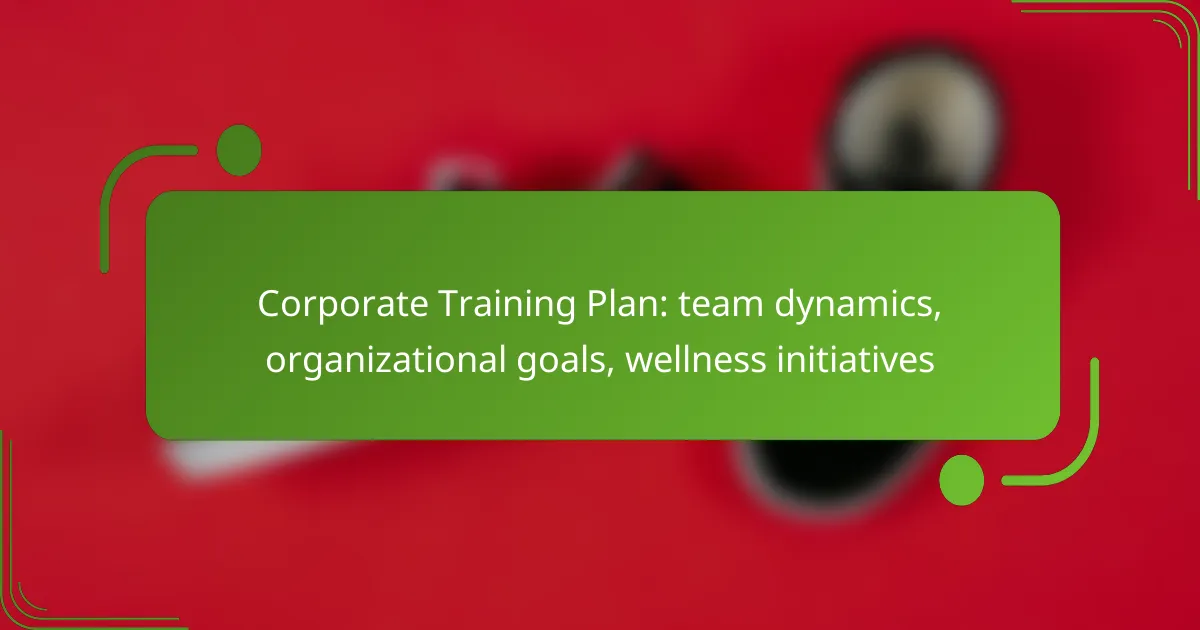A well-structured corporate training plan is essential for enhancing team dynamics and aligning individual contributions with organizational goals. By focusing on effective communication, collaboration, and wellness initiatives, organizations can create a supportive environment that boosts employee engagement and performance. This approach not only fosters a cohesive team but also promotes overall well-being, leading to a more productive workforce.

How can corporate training enhance team dynamics?
Corporate training can significantly enhance team dynamics by fostering better communication, collaboration, and conflict resolution among team members. These improvements lead to a more cohesive work environment, aligning individual efforts with organizational goals.
Improved communication skills
Effective communication is fundamental to team dynamics. Corporate training programs can focus on developing active listening, clear articulation of ideas, and constructive feedback techniques. For instance, role-playing exercises can help team members practice and refine their communication skills in a safe environment.
Consider incorporating workshops that emphasize non-verbal communication and emotional intelligence, as these elements can greatly influence team interactions. Regularly scheduled training sessions can reinforce these skills and ensure continuous improvement.
Increased collaboration
Collaboration is essential for achieving organizational goals, and corporate training can facilitate this by teaching teamwork strategies and collaborative tools. Training can introduce platforms like project management software that streamline group efforts and enhance accountability.
Encouraging cross-departmental projects during training can also break down silos and promote a culture of collaboration. Setting clear objectives and roles within these projects helps team members understand their contributions to the larger mission.
Conflict resolution strategies
Conflict is inevitable in any team setting, but corporate training can equip employees with strategies to manage and resolve disputes effectively. Training sessions can cover techniques such as mediation, negotiation, and the importance of addressing issues promptly.
Providing scenarios for practice can help team members learn how to navigate conflicts constructively. Emphasizing a problem-solving approach rather than a blame-focused mindset can foster a healthier team environment.
Trust-building exercises
Building trust among team members is crucial for effective collaboration and communication. Corporate training can include trust-building exercises that encourage vulnerability and openness, such as team retreats or trust falls.
Regularly scheduled team-building activities can reinforce relationships and create a supportive atmosphere. It’s important to choose exercises that align with the team’s comfort levels and cultural context to maximize participation and effectiveness.

What are the key components of an effective corporate training plan?
An effective corporate training plan includes a thorough needs assessment, alignment with organizational goals, and the selection of appropriate training methods. These components ensure that training initiatives are relevant, targeted, and capable of fostering team dynamics and wellness initiatives within the organization.
Needs assessment
A needs assessment identifies the skills and knowledge gaps within a team or organization. This process typically involves surveys, interviews, and performance evaluations to gather data on current competencies and desired outcomes.
To conduct an effective needs assessment, engage employees at various levels to gain diverse insights. Prioritize areas that will have the most significant impact on team dynamics and overall performance.
Goal alignment with organizational objectives
Aligning training goals with organizational objectives ensures that training efforts support the broader mission and vision of the company. This alignment helps to create a cohesive strategy that drives both individual and organizational success.
When setting training goals, consider how they can enhance team collaboration, improve productivity, and contribute to employee wellness. Regularly review and adjust these goals to stay in sync with evolving business needs.
Training methods and formats
Selecting the right training methods and formats is crucial for maximizing engagement and retention. Options include in-person workshops, online courses, and blended learning approaches that combine both.
Consider the preferences and learning styles of your team when choosing formats. For instance, interactive workshops may work well for hands-on skills, while online modules can provide flexibility for busy schedules. Aim for a mix that caters to diverse needs and promotes effective learning.

How do wellness initiatives impact employee performance?
Wellness initiatives significantly enhance employee performance by promoting physical and mental health, leading to a more engaged workforce. When employees feel supported in their well-being, they are more likely to contribute positively to their roles and the organization as a whole.
Reduced absenteeism
Implementing wellness initiatives can lead to a noticeable decrease in absenteeism. Programs that focus on health, such as fitness challenges or mental health days, encourage employees to take care of themselves, which can reduce the number of sick days taken. For instance, companies that offer health screenings or subsidized gym memberships often see absenteeism drop by a significant margin.
To maximize this benefit, organizations should regularly assess the health needs of their employees and tailor initiatives accordingly. Regular feedback can help ensure that wellness programs remain relevant and effective.
Enhanced productivity
Wellness initiatives can directly boost productivity by fostering a healthier work environment. When employees are physically fit and mentally sharp, they tend to perform tasks more efficiently and with greater focus. Studies suggest that companies with comprehensive wellness programs can experience productivity increases in the range of 10-20%.
To enhance productivity through wellness, consider implementing flexible work schedules that allow employees to engage in physical activities or mindfulness practices during the day. This approach can lead to improved concentration and output.
Improved employee morale
Wellness initiatives play a crucial role in enhancing employee morale by demonstrating that the organization values its workforce. When employees see that their employer is invested in their health and well-being, it fosters loyalty and a positive workplace culture. This can lead to lower turnover rates and a more cohesive team dynamic.
To further improve morale, organizations should encourage participation in wellness activities by creating a supportive community. Recognizing and celebrating wellness achievements, such as completing a fitness challenge, can also boost team spirit and motivation.

What are the best practices for implementing corporate training?
Effective corporate training implementation involves engaging content, regular feedback, and ongoing support. These practices ensure that training aligns with organizational goals and fosters team dynamics while promoting employee wellness.
Engaging training materials
Creating engaging training materials is crucial for maintaining participant interest and enhancing retention. Use a variety of formats such as videos, interactive modules, and real-life case studies to cater to different learning styles.
Incorporate elements like quizzes and gamification to make the learning experience more enjoyable. For example, a training program on team dynamics could include role-playing scenarios that allow employees to practice communication skills in a safe environment.
Regular feedback mechanisms
Implementing regular feedback mechanisms helps assess the effectiveness of training and identify areas for improvement. Use surveys, one-on-one check-ins, and group discussions to gather insights from participants.
Establish a feedback loop where employees can share their thoughts on the training process. This could include anonymous surveys after each session, allowing for honest input that can guide future training initiatives.
Ongoing support and resources
Providing ongoing support and resources is essential for reinforcing training concepts. Create a repository of materials, such as guides and videos, that employees can access after training sessions to refresh their knowledge.
Consider establishing mentorship programs or peer support groups to encourage continuous learning. For instance, pairing new employees with experienced mentors can facilitate knowledge transfer and strengthen team dynamics over time.

How can organizations measure the effectiveness of training programs?
Organizations can measure the effectiveness of training programs through various methods, including performance metrics, feedback from employees, and return on investment analysis. These approaches provide insights into how well training aligns with organizational goals and enhances team dynamics.
Employee performance metrics
Employee performance metrics are quantitative measures that assess the impact of training on individual and team productivity. Common metrics include sales figures, project completion rates, and customer satisfaction scores. Tracking these metrics before and after training can reveal significant improvements or highlight areas needing further development.
For example, if a sales team undergoes training on new product features, comparing sales figures from the months before and after the training can indicate its effectiveness. Aim for a clear baseline to measure progress accurately.
Surveys and feedback forms
Surveys and feedback forms are essential tools for gathering qualitative data on training effectiveness. These instruments can capture participants’ perceptions of the training content, delivery, and relevance to their roles. Regularly administering these surveys can help organizations identify strengths and weaknesses in their training programs.
Consider using a mix of rating scales and open-ended questions to gain comprehensive insights. For instance, asking employees to rate their confidence in applying new skills can provide a clear picture of training impact.
Return on investment analysis
Return on investment (ROI) analysis evaluates the financial benefits of training relative to its costs. This analysis helps organizations determine whether the training yields sufficient value to justify the investment. Calculating ROI involves comparing the monetary gains from improved performance against the costs of the training program.
To perform an ROI analysis, consider factors such as increased productivity, reduced turnover, and enhanced employee engagement. A common approach is to express ROI as a percentage, allowing for easy comparison across different training initiatives. Aim for an ROI of at least 100% to ensure that training is financially viable.

What frameworks can guide corporate training development?
Several frameworks can effectively guide corporate training development, ensuring alignment with organizational goals and team dynamics. These frameworks provide structured approaches to designing, implementing, and evaluating training programs that enhance employee performance and well-being.
ADDIE model
The ADDIE model is a widely recognized framework for developing effective training programs. It consists of five phases: Analysis, Design, Development, Implementation, and Evaluation. Each phase plays a crucial role in ensuring that training meets the specific needs of the organization and its employees.
In the Analysis phase, identify the training needs by assessing current skills and organizational goals. The Design phase involves outlining the training objectives and creating a detailed plan for content and delivery methods. During Development, the actual training materials are created, followed by Implementation, where the training is delivered to employees. Finally, Evaluation assesses the effectiveness of the training and identifies areas for improvement.
To effectively use the ADDIE model, ensure that each phase is thoroughly completed before moving to the next. Common pitfalls include rushing through the Analysis phase or neglecting the Evaluation phase, which can lead to ineffective training outcomes. Regularly revisiting and refining each phase can enhance the overall training experience.
